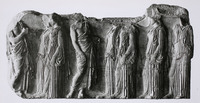| dc.coverage.temporal | creation date: 445-438 BCE | en_US |
| dc.creator | Phidias | en_US |
| dc.creator | Iktinos | en_US |
| dc.creator | Kallikrates | en_US |
| dc.date | 445-438 BCE | en_US |
| dc.date.accessioned | 2007-08-29T16:56:12Z | |
| dc.date.available | 2007-08-29T16:56:12Z | |
| dc.date.issued | -445--438 | en_US |
| dc.identifier | 112575 | en_US |
| dc.identifier.uri | http://hdl.handle.net/1721.3/21023 | en_US |
| dc.description | The plank of the Parthenon, placed in top of the wall external of the cella, represents the procession of Large Panathénées, celebrates which was held every four years and during which the Athenian people paid homage to his protective goddess, Athéna. The representation of the procession led in frontage is with the handing-over of the péplos to the goddess. Here two priests are illustrated of which one holds a basket punt and six girls of the aristocracy, called Ergastines, which holds two pertaining to worship instruments, a phiale and a burn-perfume.
In the beginning, the bottom was blue and the hair, like some parts of the body, was gilded.
<translated by Google translate from original French text>:
La frise du Parthénon, placée en haut du mur extérieur de la cella, représente la procession des Grandes Panathénées, fête qui se déroulait tous les quatre ans et au cours de laquelle le peuple athénien rendait hommage à sa déesse protectrice, Athéna. La représentation de la procession aboutissait en façade est à la remise du péplos à la déesse. Ici sont figurés deux prêtres dont l'un tient une corbeille plate et six jeunes filles de l'aristocratie, appelées Ergastines, qui tiennent deux instruments cultuels, une phiale et un brûle-parfum.
À l'origine, le fond était bleu et les cheveux, ainsi que quelques parties du corps, étaient dorés. | en_US |
| dc.description | full view | en_US |
| dc.format.extent | height: 96 cm, height: 37.8 inches, depth: 12 cm, depth: 4.72 inches, length: 207 cm, length: 81.5 inches | en_US |
| dc.format.medium | marble | en_US |
| dc.format.medium | stone | en_US |
| dc.relation.ispartof | 130963 | en_US |
| dc.subject | Friezes | en_US |
| dc.subject | Mythology | en_US |
| dc.subject | Processions | en_US |
| dc.subject | Women | en_US |
| dc.subject | Parthenon (Athens, Greece) | en_US |
| dc.subject | Classical antiquities | en_US |
| dc.subject | Greece --Antiquities | en_US |
| dc.subject | Sculpture, Greek | en_US |
| dc.subject | Reliefs (sculptures) | en_US |
| dc.title | East Frieze: procession of women | en_US |
| dc.title.alternative | Plaque dite des Ergastines : fragment de la frise est du Parthénon | en_US |
| dc.type | Image | en_US |
| dc.rights.access | All rights reserved | en_US |
| dc.publisher.institution | Repository: Musée du Louvre (Paris, France) ID: MR 825 | en_US |
| vra.culturalContext | Greek | en_US |
| vra.technique | carving (processes) | en_US |
| vra.worktype | Frieze (entablature component) | en_US |
| dc.contributor.display | architect: Iktinos (Greek (ancient), 469-430 BCE), architect: Kallikrates (Greek (ancient), 499-400 BCE), sculptor: Phidias (Greek (ancient), 525-425 BCE) | en_US |



